Degrees of Concern – Climate Change and New York City’s Future
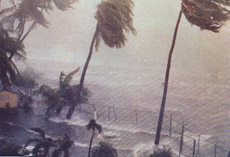 |
![]()
![]()
![]() We are living in an era of extreme weather. The 1990s was the warmest decade of the 20th century, and by some estimates the warmest decade of the past thousand years. Many scientists believe man-made changes to the world’s climate are promoting dramatic swings in the weather - more droughts and heat waves, but also more floods, hurricanes and tornadoes.
We are living in an era of extreme weather. The 1990s was the warmest decade of the 20th century, and by some estimates the warmest decade of the past thousand years. Many scientists believe man-made changes to the world’s climate are promoting dramatic swings in the weather - more droughts and heat waves, but also more floods, hurricanes and tornadoes.
How is a major city like New York affected by these changes — how can it adapt to them? Click here for the one-hour call-in special
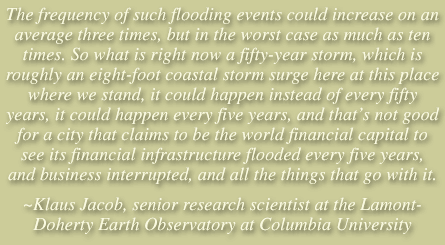
New York is the ultimate man-made environment - a place where the weather can seem irrelevant. It doesn’t matter if it’s raining or snowing, freezing-cold or hot and muggy, most of the city’s business goes on unimpeded by the forces of nature. But, in the future, quick fixes may be harder to come by. How is New York responding to the early signs of global warming?
Living on Earth explores how one major metropolitan area is dealing with what many scientists call the most pressing challenge of the 21st century – a warming world.
Degrees of Concern – Climate Change and New York City’s Future: Part 1
Jamaica Bay, a nine thousand acre salt-water estuary on the western end of Long Island is disappearing. This prime habitat is one of the most important urban wildlife refuges in the country, with over 350 species having been recorded within its boundaries. How will the bay be further impacted by Global Warming, and how will its deteriorization affect New York City and its environs?
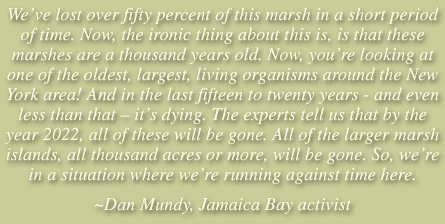
Listen to Part 1 of Degrees of Concern: Climate Change and New York City’s future. (RealPlayer | mp3)
Related Links:
– National Park Service Site
– Exploring Jamaica Bay and viewing its wildlife
– Birders’ guide to the refuge: see hawks, raptors, warblers, songbirds and waterfowl
– Jamaica Bay
Degrees of Concern – Climate Change and New York City’s Future: Part 2
We are living in an era of extreme weather. The 1990s was the warmest decade of the 20th century, and by some estimates the warmest decade of the past thousand years. Many scientists believe man-made changes to the world’s climate are promoting dramatic swings in the weather - more droughts and heat waves, but also more floods, hurricanes and tornadoes.
NYC water supply
How is a major city like New York affected by these changes — how can it adapt to them? How at-risk is New York City’s infrastructure?
 |
In New York City, one of the most vulnerable public systems is the city’s water supply. Even with aggressive water conservation, city residents can’t be assured of an adequate supply of fresh water. Ultimately the city's supply depends on natural systems – rainfall, underground aquifers, lakes and rivers. These systems could be dramatically affected by changes in the global climate.
But even aggressive water conservation can’t assure an adequate supply of fresh water. Ultimately the city's supply depends on natural systems – rainfall, underground aquifers, lakes and rivers.
New York City's water supply system is huge and complex. Twenty-two reservoirs and lakes provide water to more than nine-million residents of the city and four suburban counties, as well as the hundreds of thousands of commuters and tourists who visit the city every day. These systems could be dramatically affected by changes in the global climate. And one place where they would be first detected is along what’s knows as the “salt front” on the Hudson River.
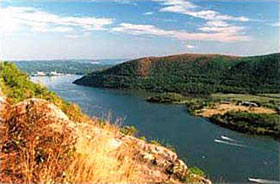
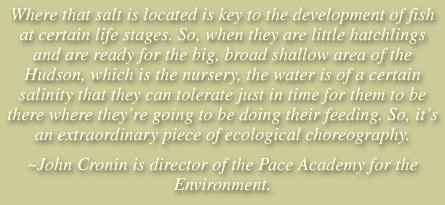
Preparing for the Flood
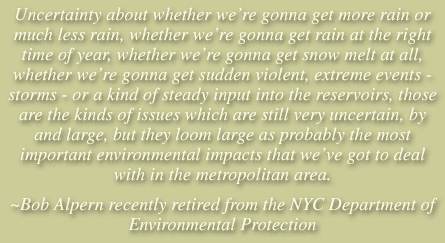
When Professor Klaus Jacob looks out over the World Trade Center site he sees a potential disaster in the making. It’s not the threat of more terrorism. Jacob worries that in the coming decades whatever is built on the site will be vulnerable to the combination of rising seas and more intense storms aggravated by climate change.
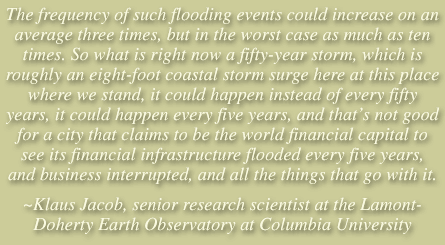
Listen to Part 2 of Degrees of Concern: Climate Change and New York City’s future. (RealPlayer | mp3)
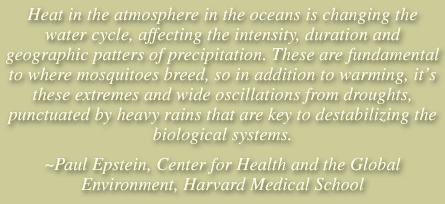
Degrees of Concern – Climate Change and New York City’s Future: Part 3
Climate Change and its effect on human health
 |
A few years ago, a group of leading researchers published a report on climate change and its human heath impacts. They concluded that changes in rainfall, temperature and other weather variables may affect the rate of vector-borne illnesses spread by ticks, mosquitoes and other carriers — illnesses such as West Nile Virus, Hunta Virus, Lyme Disease and Malaria. They also wrote that non-weather factors such as human behavior and the ability of public health infrastructures to cope with outbreaks would also play a big role.
New York City was the first place in North America to experience an outbreak of West Nile virus. What is New York doing to respond to these possible future health effects?
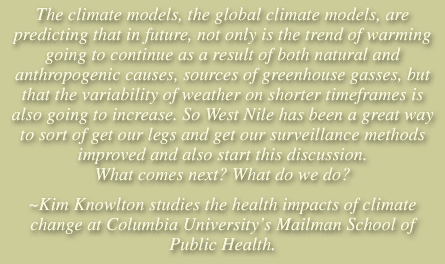
IPCC's report on climate change impact on human health
What New Yorkers are Doing to Mitigate Climate Change
Most New Yorkers probably think of climate change as some force that melts polar ice caps or inundates islands in the Pacific. Its impact on an urban area like New York is harder to comprehend.
Still, that doesn’t mean New Yorkers aren’t paying attention to climate change. Around the city a number of efforts are underway to reduce emissions of carbon dioxide and other gasses that are blamed for the man-made disruption of the climate. One such effort is a new apartment building, called the Solaire, located just a few blocks from Ground Zero in lower Manhattan.
On the building's western facade, facing the Hudson River, an array of metallic-blue photovoltaic cells captures sunlight and turns it into electricity. The cells are expected to provide about 5 per cent of the building's energy. This is one of several features intended to make the Solaire 35 per cent more energy efficient than your typical Manhattan high rise. The developers of the Solaire call it America’s first environmentally-sustainable high-rise residential building.
Click here for info on this apartment building
It may be hard to visualize the potential danger global warming could have on such a massive and resilient city as New York. But one major study shows that during a class 3 hurricane, which is not even the most severe type of storm, lower Manhattan would become its own island. The financial district, city hall, the World Trade Center site, all would be separated from the rest of New York by a mass of water.
Listen to Part Three of Degrees of Concern: Climate Change and New York City’s Future (RealPlayer | mp3)
Climate Change Related Links:
– United Nations Framework Convention on Climate Change
– Pew Center on Global Climate Change
– Climate Change and the Global City
– The Pew Center on Global Climate Change:
– Sea-Level Rise & Global Climate Change: A Review of Impacts to U.S. Coasts
– IPCC report on the economic costs of sea-level rise
– The Potential Health Impacts of Climate Variability and Change for the United States: Executive Summary of the Report of the Health Sector of the U.S. National Assessment
Back to the series and features homepage
Living on Earth wants to hear from you!
Living on Earth
62 Calef Highway, Suite 212
Lee, NH 03861
Telephone: 617-287-4121
E-mail: comments@loe.org
Newsletter [Click here]
Donate to Living on Earth!
Living on Earth is an independent media program and relies entirely on contributions from listeners and institutions supporting public service. Please donate now to preserve an independent environmental voice.
NewsletterLiving on Earth offers a weekly delivery of the show's rundown to your mailbox. Sign up for our newsletter today!
 Sailors For The Sea: Be the change you want to sea.
Sailors For The Sea: Be the change you want to sea.
 Creating positive outcomes for future generations.
Creating positive outcomes for future generations.
 Innovating to make the world a better, more sustainable place to live. Listen to the race to 9 billion
Innovating to make the world a better, more sustainable place to live. Listen to the race to 9 billion
 The Grantham Foundation for the Protection of the Environment: Committed to protecting and improving the health of the global environment.
The Grantham Foundation for the Protection of the Environment: Committed to protecting and improving the health of the global environment.
 Contribute to Living on Earth and receive, as our gift to you, an archival print of one of Mark Seth Lender's extraordinary wildlife photographs. Follow the link to see Mark's current collection of photographs.
Contribute to Living on Earth and receive, as our gift to you, an archival print of one of Mark Seth Lender's extraordinary wildlife photographs. Follow the link to see Mark's current collection of photographs.
 Buy a signed copy of Mark Seth Lender's book Smeagull the Seagull & support Living on Earth
Buy a signed copy of Mark Seth Lender's book Smeagull the Seagull & support Living on Earth

